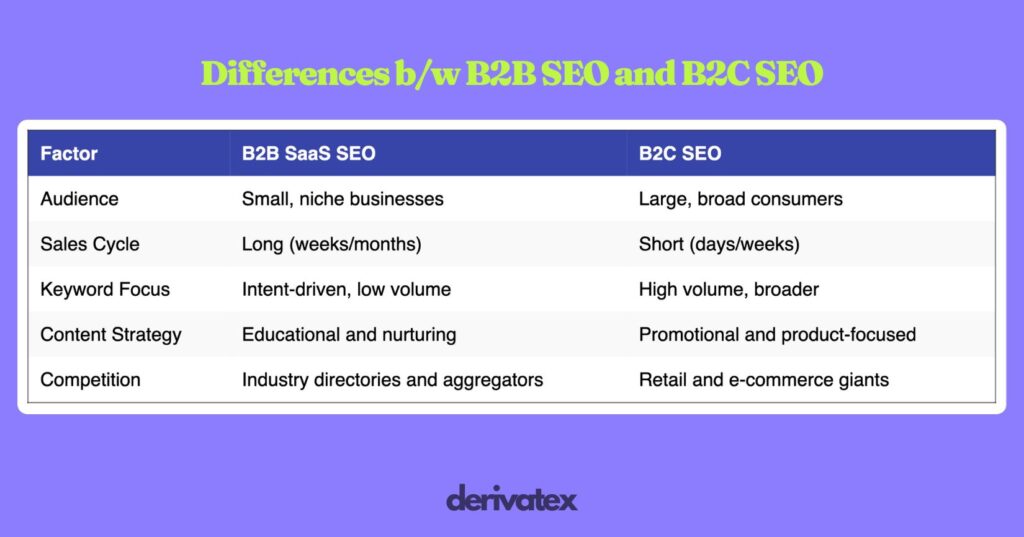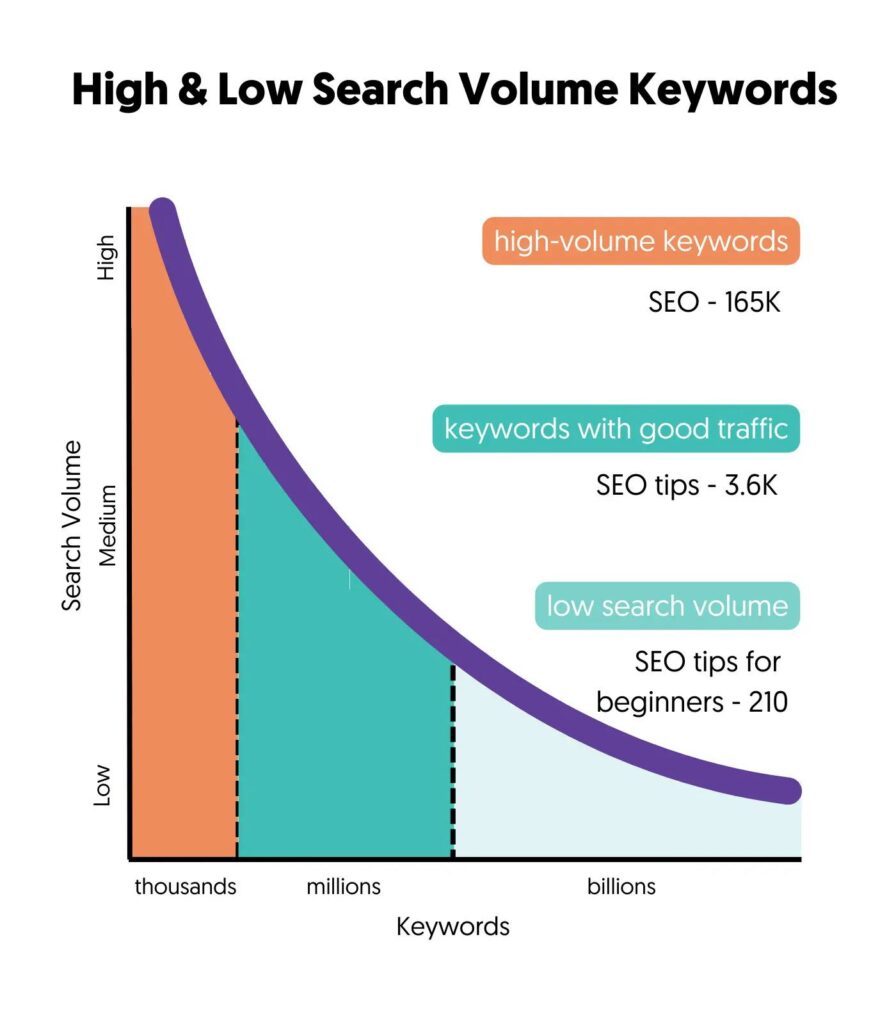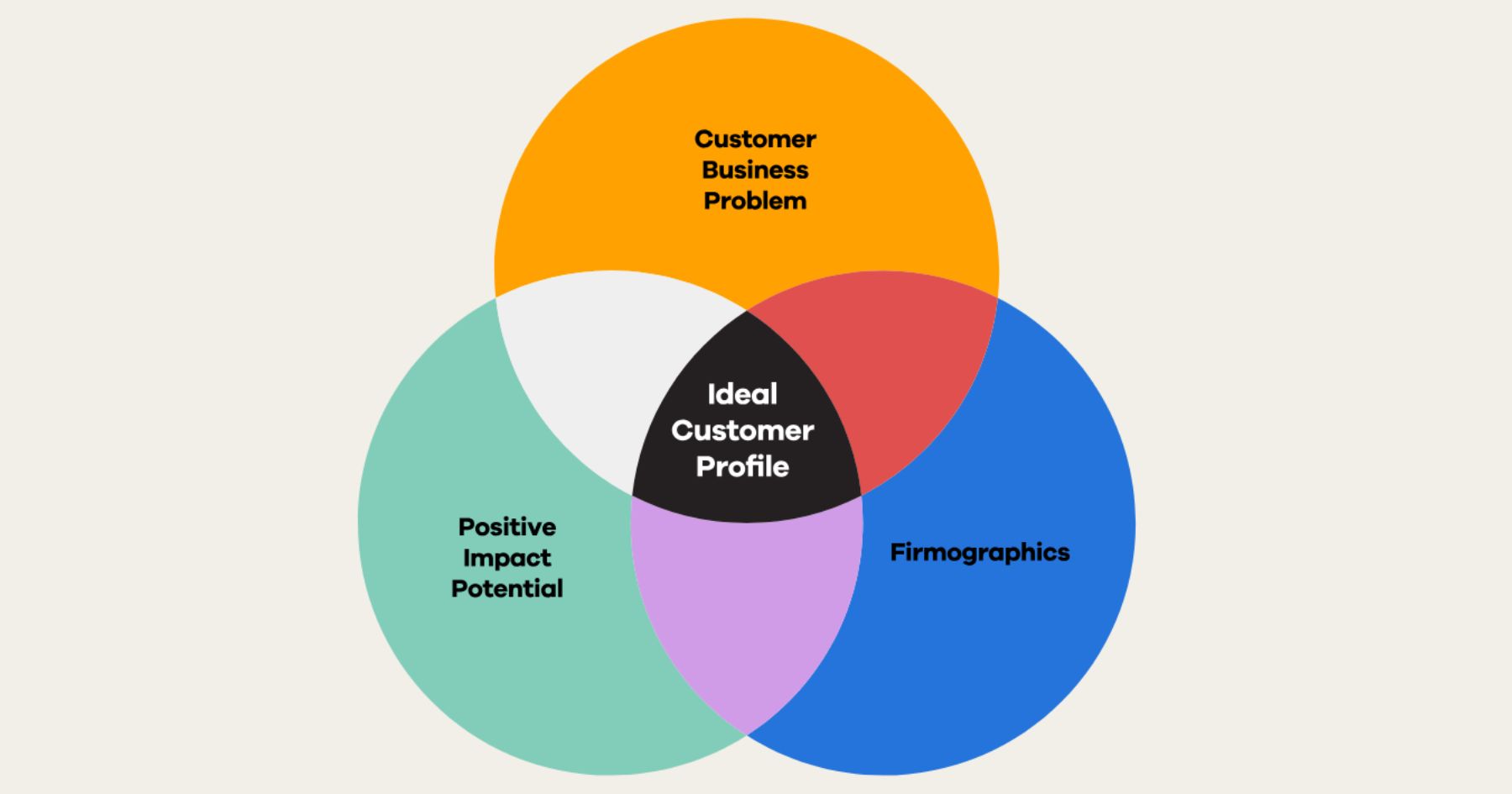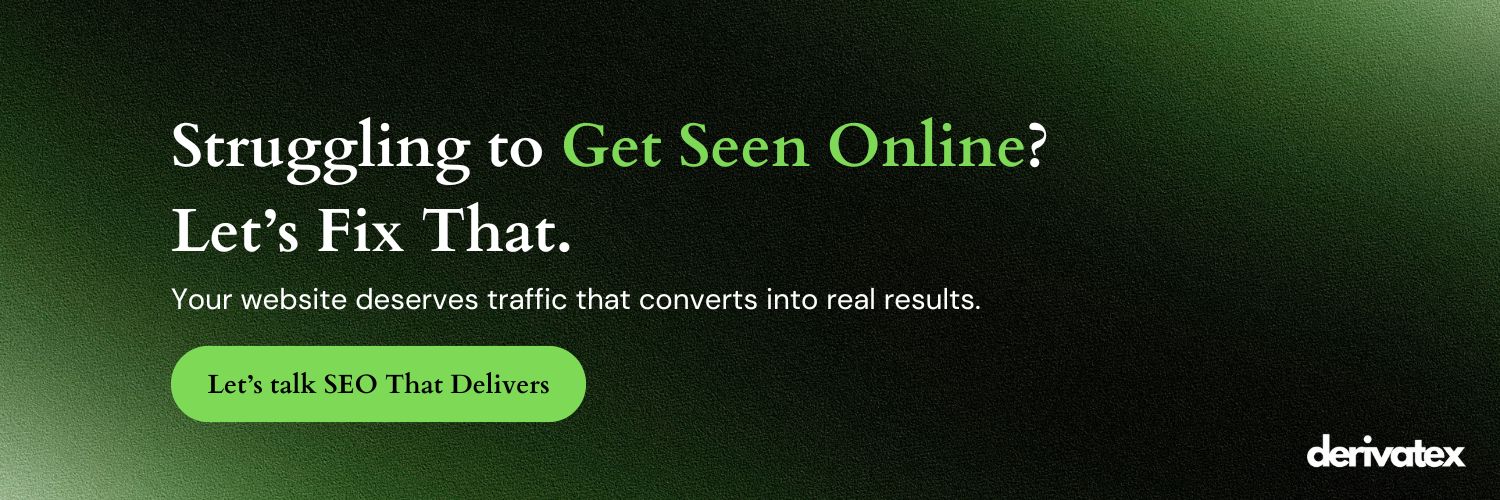Struggling to generate quality leads for your SaaS business? You’re not alone.
While many B2B SaaS companies pour thousands into paid ads, the secret to sustainable growth lies in mastering SEO.
Why?
Because organic search consistently delivers high-intent traffic—potential customers actively looking for solutions like yours.
In this guide, we’ll break down everything you need to know about B2B SaaS SEO, from creating a keyword strategy tailored to your ideal customer to implementing technical fixes that boost your rankings.
Whether you’re a startup aiming for visibility or an established SaaS looking to scale, this guide will provide actionable strategies to dominate the search engine results pages (SERPs).
Ready to unlock your SaaS platform’s potential and turn search engines into your biggest lead-generation machine? Let’s dive in.
Table of Contents
What is B2B SaaS SEO?
B2B SaaS SEO refers to the process of optimizing search engines for SaaS (Software as a Service) companies targeting other businesses. It involves tailoring your website and content to rank higher for keywords that align with your ideal customer’s search intent—driving traffic, leads, and ultimately conversions.

Unlike B2C SEO, which often focuses on high-volume keywords aimed at consumers, B2B SaaS SEO prioritizes:
- Smaller, high-value audiences: Business buyers with specific needs.
- Longer sales cycles: Decision-making involves multiple stakeholders.
- High-intent keywords: Searches like “best project management software for teams” indicate someone ready to invest.
Why is B2B SaaS SEO Critical?
In the highly competitive SaaS industry, organic search is often the most sustainable and cost-effective way to acquire leads. Paid ads may generate quick wins, but organic rankings deliver:
- Higher ROI: Once ranked, organic traffic flows without continuous ad spend.
- Authority & Trust: Ranking for industry-specific terms positions your SaaS as a leader.
- Scalability: Organic search grows with your business, helping you reach more prospects over time.
You might also like: SEO vs. Paid Ads: What’s Better for SaaS Companies?
In fact, studies show that 53% of website traffic for SaaS companies comes from organic search, making SEO an essential pillar for growth.
Challenges of SEO for B2B SaaS
B2B SaaS SEO is not your average SEO. It comes with unique challenges that demand a more tailored and strategic approach.
Here are the top hurdles you’ll face when optimizing for this niche:
1. Complex Buyer Journeys

In the B2B SaaS space, decisions are rarely made by a single individual. The buying process involves multiple stakeholders, including decision-makers, technical teams, and budget approvers. This means your SEO strategy needs to cater to different stages of the funnel, from awareness to consideration and decision.
Example: A technical lead may search for “API integration tools,” while the CFO might search for “cost-effective SaaS platforms.”
2. Low Search Volume Keywords

Unlike B2C SEO, where search terms like “best workout app” see thousands of monthly searches, B2B SaaS keywords often have lower search volumes. However, these keywords typically have higher intent, meaning users are more likely to convert into leads or customers.
Pro Tip: Don’t ignore low-volume keywords. A query with 200 monthly searches, like “enterprise SaaS SEO,” can bring in highly qualified leads.
3. High Competition
B2B SaaS companies not only compete with direct competitors but also with:
- Aggregators like Capterra and G2, which dominate search results.
- Enterprise SaaS brands with massive budgets for paid ads and content.
Standing out requires a mix of technical SEO, content marketing, and link-building strategies tailored to your niche.
4. Long Sales Cycles

The average sales cycle for B2B SaaS is often months long, meaning your SEO efforts need to account for a user’s journey over time. Content should nurture leads, addressing questions and concerns at every stage of the decision-making process.
Example: Your blog might need to rank for top-of-funnel queries like “what is SaaS SEO?” while your case studies attract bottom-of-funnel searches like “SaaS SEO case studies for fintech.”
By understanding these challenges upfront, you can build a more resilient and effective SEO strategy that addresses your audience’s needs and positions your SaaS company as a trusted solution.
Key Components of a B2B SaaS SEO Strategy
Crafting an effective B2B SaaS SEO strategy requires a deep understanding of your audience, technical excellence, and content that resonates with decision-makers.
Let’s break down the core components you need to focus on:
1. Understanding Your Ideal Customer Profile (ICP)

Your SEO strategy begins with identifying your Ideal Customer Profile (ICP)—the businesses most likely to benefit from your SaaS product. This step ensures you’re optimizing for search terms your target audience is actively using.
How to Define Your ICP for SEO:
- Analyze Customer Data: Use CRM data to identify common traits among your best customers.
- Identify Pain Points: What challenges are your customers searching for solutions to online?
- Map Buyer Personas: Include decision-makers, technical stakeholders, and end-users.
Example: Your blog might need to rank for top-of-funnel queries like “what is SaaS SEO?” while your case studies attract bottom-of-funnel searches like “SaaS SEO case studies for fintech.”
2. Keyword Research for B2B SaaS
Keyword research is the foundation of any SEO strategy, but for B2B SaaS, it’s not about chasing high search volumes. Instead, focus on high-intent keywords that reflect specific pain points or solutions.
Best Practices for Keyword Research:
- Use tools like SEMrush or Ahrefs to uncover long-tail and intent-driven keywords.
- Look at People Also Ask (PAA) questions in Google to capture related queries.
- Prioritize keywords with modifiers like:
- “Best” (e.g., “best CRM for startups”)
- “For” (e.g., “project management tools for SaaS”)
- “Software” (e.g., “SEO software for B2B”)
Pro Tip: Don’t ignore branded keywords (e.g., “[Competitor Name] alternatives”). Ranking for comparison searches can position you as a viable alternative to well-known brands.
3. On-Page SEO Best Practices
Your website is the front line of your SEO efforts. Each page should be optimized to match search intent while driving action.
Key On-Page SEO Elements:
- Title Tags & Meta Descriptions: Include your target keyword and a compelling CTA.
- Headers (H1, H2, H3): Use structured headers to guide readers and search engines.
- Internal Linking: Link to relevant blog posts, feature pages, and resources to improve crawlability and rankings.
- Call-to-Actions (CTAs): Tailor CTAs to each page’s goal, such as “Book a Demo” or “Download the Guide.”
Wrote a detailed thread on why having a demo page is extremely important. Read it below 👇
Pro Tip: Don’t ignore branded keywords (e.g., “[Competitor Name] alternatives”). Ranking for comparison searches can position you as a viable alternative to well-known brands.
4. Technical SEO for SaaS Websites
Technical SEO ensures your website is easy to crawl, index, and load—critical for search engine rankings.
Technical SEO Checklist:
- Site Speed Optimization: Use tools like Google PageSpeed Insights to improve loading times.
- Mobile Responsiveness: Ensure your site looks and functions well on all devices.
- Structured Data: Implement schema markup to enhance your SERP appearance with rich snippets.
- Fix Crawl Errors: Use Google Search Console to identify and resolve issues like 404s and redirects.
Also read: Technical SEO Checklist for Martech Websites: What You Need to Know
Pro Tip: SaaS websites often have complex structures. Conduct regular technical audits to ensure all pages are optimized.
5. Content Marketing for SaaS SEO
Content is the bridge between your audience’s pain points and your solution. High-quality content not only attracts traffic but also nurtures leads at every stage of the funnel.
Types of Content for SaaS SEO:
- Blog Posts: Address top-of-funnel queries like “What is B2B SaaS marketing?”
- Case Studies: Showcase real-world results for decision-makers in the consideration phase.
- Comparison Pages: Capture searchers comparing tools with terms like “[Competitor Name] vs. [Your SaaS].”
- Whitepapers & Guides: Build authority while collecting leads through gated content.
Example: If your SaaS offers marketing analytics tools, a blog titled “How to Measure ROI on Marketing Campaigns” could target marketing managers searching for insights.
6. Backlink Strategies for SaaS
Backlinks from reputable websites signal to Google that your content is trustworthy and authoritative.
How to Build Backlinks for SaaS:
- Guest Blogging: Write for industry-specific sites to position your SaaS as a thought leader.
- Partnerships: Collaborate with non-competing SaaS brands to create co-marketing opportunities.
- Digital PR: Publish unique data, research, or insights to attract backlinks from media outlets.
Don’t Miss:
– How Many Backlinks Per Day Is Safe? Avoid Google Penalties
– How to Hide Backlinks From Competitors: 5 Smart SEO Strategies
– How to Get Reindexed on Google After a Site Removal Without Warning
Pro Tip: Target backlinks from SaaS-related directories like G2, Capterra, and TrustRadius to improve both rankings and lead generation.
With these components in place, your B2B SaaS SEO strategy will be well-equipped to tackle complex buyer journeys, rank for high-intent keywords, and drive meaningful leads.
B2B SaaS SEO Checklist
To simplify your SEO strategy, here’s a practical checklist you can follow to optimize your website, content, and campaigns effectively.
Use this as a step-by-step guide to ensure you’re covering all the essential aspects of B2B SaaS SEO.
Measuring ROI for B2B SaaS SEO
Measuring the ROI of your B2B SaaS SEO efforts is essential to understanding what’s working, optimizing your strategy, and justifying investments to stakeholders. While SEO results often take time, the long-term benefits make it one of the most cost-effective growth strategies for SaaS businesses.
Here’s how you can track and measure the ROI of your SEO campaigns:
1. Define Key Metrics

- Organic Traffic: Monitor increases in organic sessions using Google Analytics.
- Lead Quality: Track the number of Marketing Qualified Leads (MQLs) and Sales Qualified Leads (SQLs) generated from organic traffic.
- Conversion Rates: Measure how many website visitors convert into free trials, demo bookings, or purchases.
- Customer Lifetime Value (CLV): Understand the long-term revenue generated by SEO-acquired customers.
- Customer Acquisition Cost (CAC): Calculate how SEO lowers your overall cost of acquiring new customers.
2. Set Up Tracking Goals
- Use Google Analytics to track user behavior, conversions, and traffic sources.
- Leverage Google Search Console to monitor keyword rankings and impressions.
- Integrate your CRM (e.g., HubSpot, Salesforce) with analytics tools to track organic leads through the sales pipeline.
3. Track Assisted Conversions
SEO often plays a key role in nurturing prospects who might not convert immediately. Use tools like Google Analytics to track how organic search assists other marketing channels (e.g., paid ads, email campaigns).
4. Analyze the Cost vs. Benefit
- Calculate your SEO investment (e.g., team costs, tools, content production).
- Compare it to the revenue generated from SEO-driven leads or customers.
- Use this formula:
ROI (%) = (Revenue from SEO – Cost of SEO) / Cost of SEO × 100
Check out: Enterprise SEO ROI Playbook: Metrics That Matter to CXOs
5. Set Realistic Timelines
SEO is a long-term investment. Expect measurable results within 6–12 months for most B2B SaaS companies. Monitor trends over time rather than short-term fluctuations.
By tracking these metrics and refining your strategy based on data, you’ll gain a clear understanding of how SEO contributes to your SaaS company’s bottom line. Over time, as organic rankings improve, you’ll see a compounding effect that significantly reduces reliance on paid channels.
Common Mistakes To Avoid
Good SEO is no longer about gaming the system; it’s about understanding your audience and delivering value at every stage of their journey.
B2B SaaS SEO can be a game-chaWhat is B2B SaaS SEO?nger, but even the best strategies can falter if certain mistakes are overlooked. Avoid these common pitfalls to ensure your efforts drive meaningful results:
1. Ignoring Search Intent
- Focusing only on high-volume keywords without addressing user intent leads to irrelevant traffic.
- Always match your content to what the user is looking for—whether it’s informational, transactional, or navigational.
2. Overlooking Technical SEO
- Neglecting site speed, crawlability, or mobile-friendliness can hurt rankings.
- Regular technical audits are essential to maintain a strong foundation for your SEO efforts.
3. Relying Too Much On Paid Campaigns
- Paid ads provide short-term traffic but don’t build organic authority.
- Invest in content and backlinks to create a sustainable, long-term traffic source.
4. Not Tracking The Right Metrics
- Focusing solely on traffic without measuring leads, conversions, or ROI can misguide your strategy.
- Always tie SEO performance to business outcomes like MQLs, SQLs, and revenue.
5. Producing Generic Content
- Publishing content that doesn’t address specific pain points or search queries won’t resonate with your audience.
- Focus on creating detailed, valuable, and actionable content tailored to your ICP.
6. Failed To Update Old Content
- Letting high-performing content stagnate can cause it to lose rankings over time.
- Regularly refresh old blog posts with updated stats, keywords, and examples to stay relevant.
7. Underestimating the Power of Internal Linking
- Missing opportunities to connect related pages can hurt crawlability and user experience.
- Use internal links strategically to guide users through your site and boost rankings.
8. Neglecting Competitor Analysis
- Ignoring what your competitors are doing means missing out on valuable insights.
- Study their top-ranking pages, backlinks, and content strategies to identify opportunities.
9. Overloading With Jargon
- Using overly technical language may alienate potential customers.
- Write content that is accessible to all stakeholders, not just technical decision-makers.
10. Skipping Buyer Journey Mapping
- Not aligning content with each stage of the funnel (awareness, consideration, decision) can result in poor lead nurturing.
- Ensure you have content for every stage to guide prospects toward conversion.
Avoiding these mistakes will help you build a robust and effective B2B SaaS SEO strategy that drives results while keeping your efforts aligned with your business goals.
FAQs
What is B2B SaaS SEO?
B2B SaaS SEO is the process of optimizing a SaaS company’s website to attract and convert businesses (B2B) through organic search. It focuses on targeting intent-driven keywords, creating valuable content, and improving technical SEO to reach decision-makers within businesses.
How is B2B SaaS SEO different from B2C SEO?
B2B SaaS SEO focuses on smaller, highly targeted audiences with longer sales cycles and specific intent. In contrast, B2C SEO typically caters to larger audiences with shorter decision-making times and broader keyword targeting.
Can SEO work for early-stage SaaS startups?
Yes, early-stage SaaS startups can benefit significantly from SEO by focusing on long-tail keywords, addressing niche pain points, and creating educational content to attract their target audience. This approach builds organic authority and reduces dependency on paid campaigns.
How do I measure the success of B2B SaaS SEO?
You can measure success by tracking metrics such as organic traffic, keyword rankings, MQLs, SQLs, conversion rates, and customer lifetime value (CLV). Tools like Google Analytics and Google Search Console are essential for this process.
How do backlinks improve B2B SaaS SEO?
Backlinks signal to search engines that your content is credible and authoritative. For SaaS, securing backlinks from trusted industry directories, guest posts, and co-marketing initiatives can boost your rankings and referral traffic.
How do I handle low search volumes in B2B SaaS SEO?
Low search volumes are common in B2B SaaS but are often tied to high intent. Focus on niche, long-tail keywords that align with your ICP’s specific needs. Additionally, create content clusters around broader topics to drive more traffic.
How long does it take to see results from B2B SaaS SEO?
SEO typically takes 6–12 months to show measurable results, depending on your niche, competition, and execution. Consistent efforts in content creation, link building, and technical optimization can accelerate this timeline.
Conclusion
B2B SaaS SEO is the key to unlocking sustainable growth and driving high-quality leads for your SaaS business. Unlike paid ads, which stop generating traffic once the budget is exhausted, SEO builds long-term visibility and authority, ensuring your SaaS solution is always in front of the right audience.
By focusing on the unique challenges of B2B SaaS SEO—such as complex buyer journeys, low search volumes, and high competition—you can craft a strategy that addresses your audience’s needs at every stage of the funnel. From conducting thorough keyword research to optimizing technical elements, building backlinks, and creating valuable content, every effort compounds to deliver results over time.
Start by implementing the practical checklist provided in this guide, and avoid common mistakes to maximize your ROI. Remember, the benefits of SEO extend beyond rankings—they lead to stronger brand authority, improved trust, and more meaningful customer relationships.
Ready to scale your SaaS business with a tailored SEO strategy? Book a free consultation with Derivate X today and let’s turn your website into your most powerful lead-generation machine.


GIPHY App Key not set. Please check settings